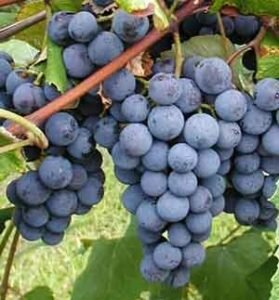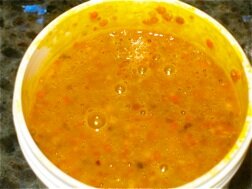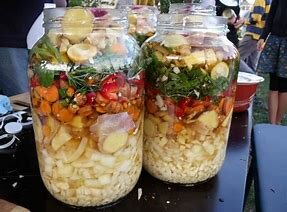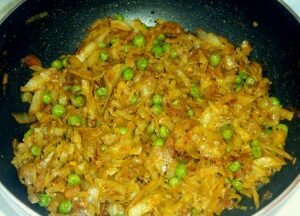This post will cover fermentation with wild yeast and bacteria. Before the isolation of yeast strains by traditional peoples the use of wild yeast was the only way to prolong food stores. However, other methods were used, too, like drying and salting of meats and fish or seeds and grains.
Later, through the years, each culture of indigenous peoples saved certain culture strains for continued use until today. These included yogurt bacteria, molds used for tempeh and koji, and bacteria/yeast used for water kefir and kombucha.

Basically, what yeast does is convert sugar into alcohol and carbon dioxide gas (CO2). In fact, if you take a look at the origin of the word yeast, you’ll discover that it comes from the Old English gist and Old High German jesen or gesen, which mean “to ferment.” You may not realize it, but wild yeast spores are present everywhere. They’re in the air we breathe; in plants, flowers, fruits, and soil. With continued experimentation with fermenting and brewing, one will keep finding more and more sources of wild yeast.
Those who wild craft for food stocks know how potent the wild yeasts are in nature. One of the better known foods that carry wild yeast are berries. Blackberries and raspberries placed in a sugar liquid produced a nice effervescent beverage that can be taken home or used right in the field the next day when camping or hiking. Black elderberries, whether fresh or naturally dried, also produces a nice fizzy elixir when made in the same manner.
Another well know fruiting body that carries beneficial bacteria are vineyard grapes or wild ones. This is seen as a white residue on the outside of the grapes.
 Rose hips harvested after the first frost also contains wild yeast and/or bacteria. Any type of wild edible berry will contain the yeast and bacteria needed for making fermented beverages.
Rose hips harvested after the first frost also contains wild yeast and/or bacteria. Any type of wild edible berry will contain the yeast and bacteria needed for making fermented beverages.
~ Good Sources of Wild Yeasts ~
 – Organic grapes, plums, fruits that have a white bloom.
– Organic grapes, plums, fruits that have a white bloom.
– Elderberries
– Wild grapes
– Elder flowers
– Blueberries
 – Blackberries/Raspberries
– Blackberries/Raspberries
– Fresh or Dried Figs
– Prickly pear fruits
– Tree barks—birch (Betula spp.) and aspen (Populus spp.).
– Unripe pine cones. My pinyon pine cones were loaded with yeast, and many people have reported excellent results using unripe pine cones from their local pines.
– Pinyon pine or white pine branches.
– Raw local honey
– A lot of unwashed organic fruits (apples, peaches, lemons, etc.) are also excellent sources of yeast. Make sure they’re organic and clean.
~ Other Items That Contain Beneficial
Wild Yeast ~
 There are other items found in nature that allows for fermentation. Pollen from flowers contain wild yeast, so many are used for culturing pro-biotic drinks. Massive amounts of yeast are within the bee pollen from the array of flowers that the bees have collected.
There are other items found in nature that allows for fermentation. Pollen from flowers contain wild yeast, so many are used for culturing pro-biotic drinks. Massive amounts of yeast are within the bee pollen from the array of flowers that the bees have collected.
Pollen extracts are sometimes used to help desensitize plants to which they are allergic. In addition, melbrosia, a mixture of fermented bee pollen, flower pollen and royal jelly, may treat menopausal symptoms in women, including headaches and urinary incontinence.
Pollen contains many nutrients(enzymes and high quality proteins). However, due to the external structure of the cell wall it is hard for humans to digest and use these nutrients. Adding the pollen to milk kefir or water kefir grains allows the cell wall to break down.
Here are a couple recipes for using bee pollen for a healthy pro-biotic beverage:
 Super – Pollen – D’Probiotica
Super – Pollen – D’Probiotica
For Dairy Kefir:
– Add 1 tbsp of fresh bee pollen to 1 cup strained kefir. Ferment in a glass jar with the lids cracked slightly or use an air-lock to vent. Ripen at room temperature for 1 to 3 days day tell fermentation starts or to one’s liking.
For Water Kefir:
– Add 1 tbsp bee pollen to 2 cups finished water kefir liquid.
Ferment for 48 hours or to taste.
 The Butterfly
The Butterfly
A great fruity beverage to use some milk kefir.
– 2/3 cup of dark grape juice
– 1/3 cup fresh milk kefir(grains removed)
– 1 tbsp of fresh pollen
– A slice of lemon or orange, with peel
– Sprinkle of cinnamon
Start with the grape juice and add the pollen. Now add the dairy kefir, swirl a bit with a straw or chopstick to marble the beverage. Allow to set for a few hours to incorporate and break down the bee pollen.
 Wild Nettle or Dandelion, Raw Bee Pollen, & Raw Honey Kraut
Wild Nettle or Dandelion, Raw Bee Pollen, & Raw Honey Kraut
Here a great recipe to make sauerkraut using wildcrafted ingredients:
– To begin you will need a 1/2 gallon sized ball jar, 1 medium cabbage, fresh nettle or dandelion leaves, local raw honey, raw bee pollen, and some sea salt.
– Now core and shred the cabbage, salt it to taste then spread on a tray or large bowl. Use as much salt to taste, common is 2 to 3 % salt brine. Allow to sit for an hour for the salt to start breaking down the cabbage.
– Pound the cabbage with a wooden hammer (or a rolling pin can work) until the juices start to release and the cabbage softens.
– Mix with bee pollen, drizzle honey and sprinkle in cleaned and greens, with steams removed. Add these ingredients to one’s liking.
– Place in a wide mouth ball jar and press down with your fist (you can use a cabbage leaf as a top barrier and then press on that) until the veg is submerged in liquid. If there is not enough liquid to start, check in a few hours as the cabbage breaks down more.
– Cover and leave at room temp for about 5-10 days. Check on the sauerkraut and keep pressing it down below the liquid and release the gas occasionally as it starts to ferment. The kraut should taste tart yet sweet from the honey when it’s ready… if a stronger sauerkraut is desired leave it at room temperature. When you are satisfied with the taste, transfer to cold storage where it will last for up to 12 months.
There are many ways to collect and use wild yeast from nature. Unlike standard yeast used for yogurts or miso wild yeast can very in strength and potency. This can affect the results of the finished beverage, however, most will turn out with high rates of effervesce. Try using other flowers and fruits or even leaves from edible wild crafted plants.
– Fin























 ~ Sagyua, Gaam, Bae Kimchi ~ Instant Apple, Pear, and Persimmon Kimchi (Traditional Winter Type)
~ Sagyua, Gaam, Bae Kimchi ~ Instant Apple, Pear, and Persimmon Kimchi (Traditional Winter Type)
 Mother In-law’s Kim-Chi Baechu Gutjori (Traditional)
Mother In-law’s Kim-Chi Baechu Gutjori (Traditional) Directions:
Directions:


 Note:
Note: